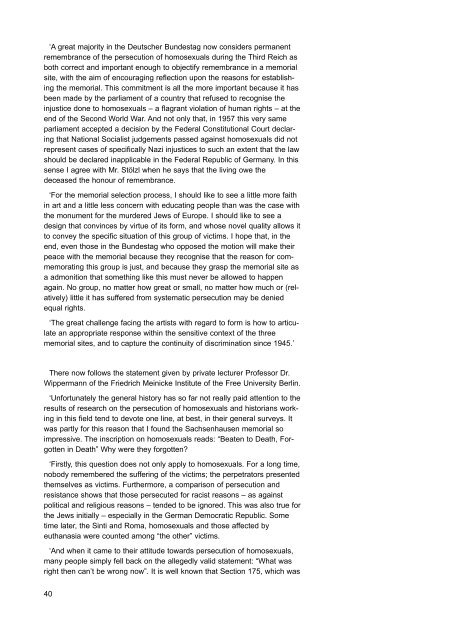Download PDF - Gedenkort für die im Nationalsozialismus ...
Download PDF - Gedenkort für die im Nationalsozialismus ...
Download PDF - Gedenkort für die im Nationalsozialismus ...
Sie wollen auch ein ePaper? Erhöhen Sie die Reichweite Ihrer Titel.
YUMPU macht aus Druck-PDFs automatisch weboptimierte ePaper, die Google liebt.
‘A great majority in the Deutscher Bundestag now considers permanentremembrance of the persecution of homosexuals during the Third Reich asboth correct and <strong>im</strong>portant enough to objectify remembrance in a memorialsite, with the a<strong>im</strong> of encouraging reflection upon the reasons for establishingthe memorial. This commitment is all the more <strong>im</strong>portant because it hasbeen made by the parliament of a country that refused to recognise theinjustice done to homosexuals – a flagrant violation of human rights – at theend of the Second World War. And not only that, in 1957 this very sameparliament accepted a decision by the Federal Constitutional Court declaringthat National Socialist judgements passed against homosexuals did notrepresent cases of specifically Nazi injustices to such an extent that the lawshould be declared inapplicable in the Federal Republic of Germany. In thissense I agree with Mr. Stölzl when he says that the living owe thedeceased the honour of remembrance.‘For the memorial selection process, I should like to see a little more faithin art and a little less concern with educating people than was the case withthe monument for the murdered Jews of Europe. I should like to see adesign that convinces by virtue of its form, and whose novel quality allows itto convey the specific situation of this group of vict<strong>im</strong>s. I hope that, in theend, even those in the Bundestag who opposed the motion will make theirpeace with the memorial because they recognise that the reason for commemoratingthis group is just, and because they grasp the memorial site asa admonition that something like this must never be allowed to happenagain. No group, no matter how great or small, no matter how much or (relatively)little it has suffered from systematic persecution may be deniedequal rights.‘The great challenge facing the artists with regard to form is how to articulatean appropriate response within the sensitive context of the threememorial sites, and to capture the continuity of discr<strong>im</strong>ination since 1945.’There now follows the statement given by private lecturer Professor Dr.Wippermann of the Friedrich Meinicke Institute of the Free University Berlin.‘Unfortunately the general history has so far not really paid attention to theresults of research on the persecution of homosexuals and historians workingin this field tend to devote one line, at best, in their general surveys. Itwas partly for this reason that I found the Sachsenhausen memorial so<strong>im</strong>pressive. The inscription on homosexuals reads: “Beaten to Death, Forgottenin Death” Why were they forgotten?‘Firstly, this question does not only apply to homosexuals. For a long t<strong>im</strong>e,nobody remembered the suffering of the vict<strong>im</strong>s; the perpetrators presentedthemselves as vict<strong>im</strong>s. Furthermore, a comparison of persecution andresistance shows that those persecuted for racist reasons – as againstpolitical and religious reasons – tended to be ignored. This was also true forthe Jews initially – especially in the German Democratic Republic. Somet<strong>im</strong>e later, the Sinti and Roma, homosexuals and those affected byeuthanasia were counted among “the other” vict<strong>im</strong>s.‘And when it came to their attitude towards persecution of homosexuals,many people s<strong>im</strong>ply fell back on the allegedly valid statement: “What wasright then can’t be wrong now”. It is well known that Section 175, which was40


